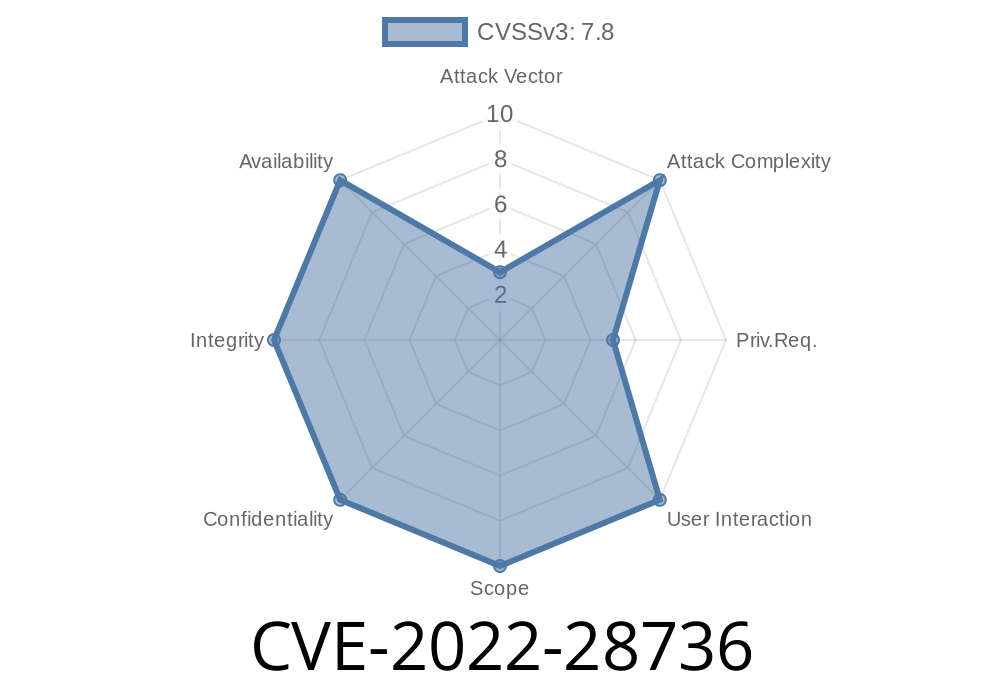In June 2022, a critical use-after-free vulnerability was disclosed in GRUB2, the widely-used bootloader for Linux systems. This post breaks down CVE-2022-28736—found in the grub_cmd_chainloader() function—and explains how this bug can be exploited by attackers, using understandable language and example code.
What is CVE-2022-28736?
CVE-2022-28736 is a use-after-free vulnerability in GRUB2, specifically in the implementation of the chainloader command, which loads and executes other bootloaders or operating systems. The vulnerability appears when chainloader is run multiple times in a single GRUB session. Essentially, memory that was previously freed by one chainloader invocation can be used again by the next invocation. If an attacker can manipulate GRUB2’s memory allocation, they can possibly expose sensitive data or execute arbitrary code during the system boot process.
Why is the Chainloader Command Important?
GRUB2 natively supports multiboot-compliant operating systems. For other OSes (like Windows), GRUB2 uses the chainloader command. This command is crucial for dual-boot configurations and legacy compatibility.
Example GRUB command
chainloader (hd,1)/boot/bootsect.bin
boot
Understanding the Use-After-Free Bug
A use-after-free happens when a program continues to use memory after it has been freed (released). In this specific case, after using chainloader the first time, a specific memory area is freed. When you run chainloader again, that same memory region, which should be off-limits, is used again, but its content could have changed in between.
Here is a simplified C-like pseudocode illustrating the problem
void grub_cmd_chainloader(int argc, char **args) {
void *image;
image = grub_malloc(IMAGE_SIZE); // Allocate memory
load_image(image, args[]); // Load boot image
grub_free(image); // Free memory
// Next invocation may re-use the same memory!
// image pointer now points to freed memory
}
If an attacker manages to influence the heap allocations, they can arrange for the freed memory to be reallocated with malicious data, which could then be executed or read by the bootloader.
Attack Surface
- Requires access to GRUB2—this can be from a local console (physical access) or if a system is configured to allow arbitrary GRUB command execution (rare but possible).
Potential to leak sensitive data such as passwords or secrets that were stored in freed memory.
- More severely, if the allocator is manipulated, arbitrary code execution at the bootloader level is possible. This could compromise the whole system before the operating system even starts.
An attacker’s simple workflow might look like
1. Trigger multiple chainloaders: Run chainloader multiple times on different “images” in the same GRUB2 session.
2. Heap spraying: Try to reset memory allocation patterns or fill freed areas with attacker-controlled data.
3. Hijack control flow: If the freed memory is reallocated with malicious data, cause GRUB2 to execute this data during the boot process.
While building a practical exploit is technically challenging and often requires deep knowledge of GRUB2 internals and heap management, the vulnerability opens a dangerous window.
Sample Proof of Concept
Here is a sketch of how to reproduce the use-after-free scenario from the GRUB command line (in a controlled, non-destructive environment):
set root=(hd,1)
chainloader +1
# Normally, boot follows here.
# Now, invoke chainloader again with some other image:
chainloader (hd,2)/some_other_image
# If the memory was reused, and some attacker code is there, it could run.
*Note: In a real attack, the second image might be a custom-crafted payload.*
Official References
- GRUB project bug report
- MITRE CVE Entry for CVE-2022-28736
- Vendor Advisory (Canonical/Ubuntu)
- Original patch
Mitigation
- Update GRUB2 immediately: All major Linux distros have patched this. Make sure your system uses the latest version.
Example to set a GRUB password (in /etc/grub.d/40_custom)
set superusers="admin"
password_pbkdf2 admin <password-hash>
Conclusion
CVE-2022-28736 is a reminder that even early-stage software like bootloaders must be carefully audited for memory safety. While this vulnerability requires some specialized circumstances to exploit, its impact is severe—including the possibility of persistent, stealthy compromise that survives reboots and evades regular OS-level protections. Always keep your boot components up to date.
*This post is an exclusive, clear-language writeup. If you want to learn about more vulnerabilities like this, check out the references provided and consider following the latest security advisories for your Linux distribution.*
Timeline
Published on: 07/20/2023 01:15:00 UTC
Last modified on: 08/25/2023 23:15:00 UTC
